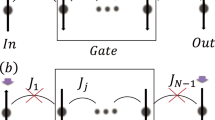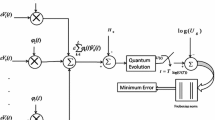Abstract
We show that a local unitary (LU) equivalent Fredkin gate can be obtained from the free evolution of three mixed-spin qubits by virtue of numerical simulation with only one step. The spin-1 qubit acts as the control qubit, and two spin-1/2 qubits, which interact with the spin-1 qubit via the first neighbor spin interaction, respectively, play the role of target qubits. We also examine the imperfect Fredkin gate operation by considering the effects of nonidentical coupling constants, uniform and inhomogeneous magnetic fields.
Similar content being viewed by others
References
Feynman R P. Simulating physics with computers. Int J theor Phys, 1982, 21: 467–488
Deutsch D. Quantum theory, the Church-Turing principle and the universal quantum computer. Proc Roy Soc Lond A, 1985, 400: 97–117
Shor PW. Algorithms for quantum computation: discrete logarithms and factoring. In Proceedings of the 35th Annual Symposium on the Foundation of Computer Science. CA, Los Alamitos: IEEE Computer Society Press, 1994. 124–134
Grover L K. Quantum computers can search rapidly by using almost any transformation. Phys Rev Lett, 1998, 80: 4329–4332
Cirac J I, Zoller P. Quantum computations with cold trapped ions. Phys Rev Lett, 1995, 74: 4091–4094
Barenco A, Deutsch D, Ekert A. Conditional quantum dynamics and logic gates. Phys Rev Lett, 1995, 74: 4083–4086
Sleator T, Weinfurter H. Realizable universal quantum logic gates. Phys Rev Lett, 1995, 74: 4087–4090
Gershenfeld N A, Chuang I L. Bulk spin-resonance quantum computation. Science, 1997, 275: 350–356
Knill E, Laflamme R, Milburn G J. A scheme for efficient quantum computation with linear optics. Nature, 2001, 409(6816): 46–52
Loss D, DiVincenzo D P. Quantum computation with quantum dots. Phys Rev A, 1998, 57: 120–126
Kane B E. A silicon-based nuclear spin quantum computer. Nature, 1998, 393(6681): 133–137
Vrijen R, Yablonovitch E, Wang K, et al. Electron-spin-resonance transistors for quantum computing in silicon-germanium heterostructures. Phys Rev A, 2000, 62: 012306-1–10
DiVincenzo D P, Bacon D, Kempe J, et al. Universal quantum computation with the exchange interaction. Nature, 2000, 408(6810): 339–342
Benjamin S C. Simple pulses for universal quantum computation with a Heisenberg ABAB chain. Phys Rev A, 2001, 64: 054303-1–3
Benjamin S C. Quantum computing without local control of qubit-qubit interactions. Phys Rev Lett, 2001, 88: 017904-1–4
Zhou X, Zhou Z W, Guo G C, et al. Quantum computation with untunable couplings. Phys Rev Lett, 2002, 89: 197903-1–4
Benjamin S C, Bose S. Quantum computing with an always-on Heisenberg interaction. Phys Rev Lett, 2003, 90: 247901-1–4
Benjamin S C, Bose S. Quantum computing in arrays coupled by “always-on” interactions. Phys Rev A, 2004, 70: 032314-1–7
Wang F, Jia H H, Zhang H L, et al. Thermal entanglement in a mixed-spin Heisenberg XXZ model under a nonuniform external magnetic field. Sci China Ser G-Phys Mech Astron, 2009, 52(12): 1919–1924
Ye M Y, Zhang Y S, Guo G. Quantum entanglement and quantum operation. Sci China Ser G-Phys Mechs Astron, 2008, 51(1): 14–21
Ma X S, Zhang J Y, Cong H S, et al. Effect of Dzialoshinski-Moriya interaction on thermal entanglement of a mixed-spin chain. Sci China Ser G-Phys Mech Astron, 2008, 51(12): 1897–1904
Hu M L, Tian D P. Effects of impurity on the entanglement of the three-qubit Heisenberg XXX spin chain. Sci China Ser G-Phys Mech Astron, 2007, 50(2): 208–214
Wei D X, Yang X D, Luo J, et al. NMR experimental implementation of three-parties quantum superdense coding. Chin Sci Bull, 2004, 49(5): 423–426
Liu W Z, Zhang J F, Deng Z W, et al. Simulation of general three-body interactions in a nuclear magnetic resonance ensemble quantum computer. Sci China Ser G-Phys Mech Astron, 2008, 51(8): 1089–1096
Liu WZ, Zhang J F, Cao Y, et al. Nuclear magnetic resonance implementation of universal quantum gate with constant Hamiltonian evolution. Appl Phys Lett, 2009, 94: 064103-1–3
Nielsen M A, Chuang I L. Quantum Computation and Quantum Information. Cambridge: Cambridge University Press, 2000
Chuang I L, Yamamoto Y. Simple quantum computer. Phys Rev A, 1995, 52: 3489–3496
Zou X B, Kim J, Lee H W. Generation of two-mode nonclassical motional states and a Fredkin gate operation in a two-dimensional ion trap. Phys Rev A, 2001, 63: 065801-1–3
Shao X Q, Chen L, Zhang S, et al. Swap gate and controlled swap gate based on a single resonant interaction with cavity quantum electrodynamics. Phys Scr, 2009, 79: 065004-1–6
Shao X Q, Chen L, Zhang S. Three-qubit Fredkin gate based on cavity quantum electrodynamics. Chin Phys B, 2009, 18(8): 3258–3264
Yung M H, Leung D W, Bose S. An exact effective two-qubit gate in a chain of three spins. Quantum Inf Comput, 2004, 4: 174–181
López G V, Lara L. Numerical simulation of a controlled-controlled-not (CCN) quantum gate. J Phys B, 2006, 39: 3897–3904
Wang X. Entanglement in the quantum Heisenberg XY model. Phys Rev A, 2001, 64: 012313-1–7
Sun Z, Wang X, Hu A, et al. Entanglement properties in (12, 1) mixed-spin Heisenberg systems. Physica A, 2006, 370: 483–500
Yang G H, Zhou L. Entanglement properties of a two-qubit, mixed-spin, Heisenberg chain under a nonuniform magnetic field. Phys Scr, 2008, 78: 025703
Author information
Authors and Affiliations
Corresponding author
Rights and permissions
About this article
Cite this article
Fan, Q. Implementation of the Fredkin gate with a three-qubit mixed-spin Heisenberg model. Sci. China Phys. Mech. Astron. 53, 1276–1280 (2010). https://doi.org/10.1007/s11433-010-3209-9
Received:
Accepted:
Published:
Issue Date:
DOI: https://doi.org/10.1007/s11433-010-3209-9




